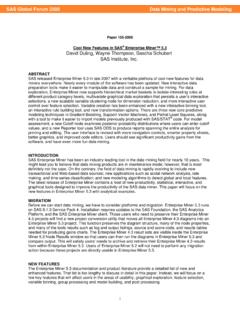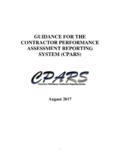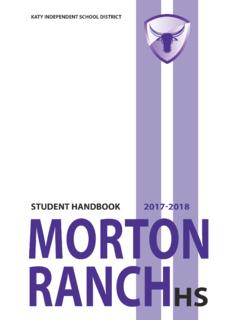Transcription of Engineering Issue: Indoor Air Vapor Intrusion …
1 PEAT able of Contents1 PURPOSE 12 INTRODUCTION Subject and Intended Audience Overview of Contaminant Entryinto Structures and Mitigation Vapor Intrusion into Various Building Types Quality Assurance Considerations 83 AVAILABLE ENGINEEREDCONTROL MEASURES Active and Passive Sub-slab Ventilation Sealing of Penetrations and Entryways Passive Barriers (including Membranes) Natural Ventilation and HVAC Modifi cation Air Cleaning using Adsorbents, Scrubbersor Photocatalytic Oxidation Combinations of Multiple Technologies 264 SELECTING A TECHNOLOGY Concentration Limits for the Contaminant Reliability Effect of the Technology on OtherAspects of Indoor Air Quality Structural and Occupancy Aspectsfor New and Existing Buildings Cost Factors Risk Communication and Stakeholder Involvement Considerations 345 VERIFICATION OFMITIGATION PERFORMANCE Defi ning the Performance Objective Defi ning the Performance Baseline
2 Methods of Measuring Indoor Contaminants Measuring or Estimating Sub-slab SoilGas Concentrations During Mitigation Indirect Measurements of Mitigation Performance Initial and Long-Term Verifi cationof System Performance The Role of Ongoing WarningDevices and System Labeling 426 ACRONYMS AND ABBREVIATIONS 437 ACKNOWLEDGMENTS 438 REFERENCES 44 Indoor Air Vapor Intrusion Mitigation Approaches1 PURPOSEThe Environmental Protection Agency (EPA) Engineering Issue in one of a new series of technology transfer documents that sum-marize the latest available information on selected treatment and site remediation technologies and related issues.
3 The Engineering Issues are designed to help remedial project managers (RPMs), on-scene coordinators (OSCs), contractors, and other site managers under-stand the type of data and site characteristics needed to evaluate a technology for potential applicability to their specifi c sites. Each En-gineering Issue document is developed in conjunction with a small group of scientists inside the EPA and with outside consultants and relies on peer-reviewed literature, EPA reports, Web sources, current research, and other pertinent information.
4 The purpose of this docu-ment is to present the state of the science regarding management and treatment of Vapor Intrusion into building feasible, this information relies on independently reviewed mitigation performance information. In an effort to keep this Engi-neering Issue paper concise, important information is summarized, while references and Web links are provided for readers interested in additional information; these Web links, verifi ed as accurate at the time of publication, are subject to change.
5 Although we have endeavored to make these links fully functional with a mouse click, if they do not function on your system, you may need to copy them into your browser or reenter them. As science and technology associ-ated with this route of exposure continues to develop, other mitiga-tion measures may become Subject and Intended Audience Vapor Intrusion is defi ned as the migration of volatile contaminants from the subsurface into overlying buildings. Volatile contaminants from buried wastes and/or contaminated groundwater or soil can migrate through subsurface soils and into Indoor air spaces of overly-ing buildings.
6 The Vapor Intrusion risk pathway may be important for buildings with or without a basement (EPA, 2002a). Vapor Intrusion issues are widespread; for example, as of March 15, 2006, there were 268 site investigations in the State of New York and mitigations were underway or completed at 72 of those sites 2 Enginneering Issue:: Indoooor Air Vappor IIntruusionn Mitiggattion AAppproaacchhes(Anders, 2006). Similar studies and mitigations have been carried out in a large number of the paper is focused on the mitigation of Vapor in-trusion to prevent human exposure to anthropogenic soil and groundwater contaminants.
7 This document is designed to provide suffi cient information to allow the reader to understand the range of mitigation technolo-gies available. The document also provides information on selecting appropriate technologies in consultation with qualifi ed Engineering and risk management profes-sionals. The intent is not to provide detailed engineer-ing protocols, nor to provide lists of vendors. Rather, it is intended that the reader will be generally informed to make appropriate selections, and to evaluate the recom-mendations of mitigation contractors and primary target audience for this paper includes EPA staff, regional program offi ces, RPMs and state govern-ment environmental staff.
8 Others who may be interested in this document may include: Engineering consultants Building professionals, including architects, property developers, contractors and engineers Health and safety/industrial hygiene specialists Stakeholder groups and the general publicBecause of its concentration on Vapor Intrusion mitiga-tion, this paper will not directly consider the and Risk Assessment TechniquesVapor Intrusion is typically fi rst evaluated with charac-terization measurement and risk assessment techniques.
9 This document will not provide much discussion of these topics, which are covered in EPA s draft Vapor in-trusion guidance document (EPA, 2002a; ) and are expected to be the subject of an upcoming revised The reader should therefore consult the EPA guidance and other appropriate documents [for example, Interstate Technology and Regulatory Council (ITRC) at and ] for information on issues such as fate and transport of volatile organic compounds (VOCs) in the subsur-face, assessment methods, risk assessment, and regulatory standards.
10 Much of the regulatory authority in this area resides with the individual states. Rather, this paper is focused on solutions that can be implemented once an unacceptable risk from Vapor Intrusion is determined to exist, or as precautionary measures. As further discussed below, the type of control implemented will be based on many factors including site use, amount of impact, cost, and regulatory accep-tance, but can be generally broken into two classes of solutions: source control and controls implemented at the in the plumes or at the sources will even-tually mitigate potential exposure pathways and can include any of the following.
















